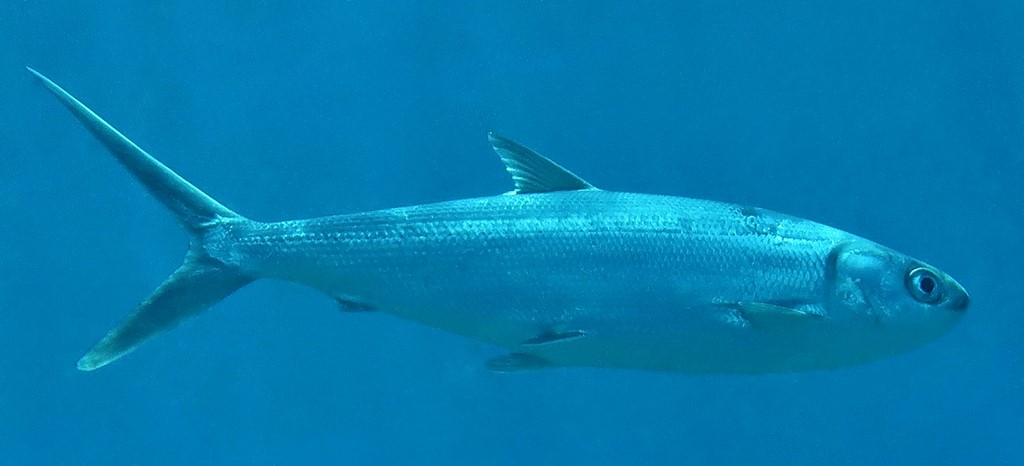CHANOS CHANOS - (FABRICIUS, 1775)
Picture courtesy of: Alain Daoulas
Actinopterygii (Gigaclass) > Actinopteri (Class) > Teleostei (Subclass) > Gonorynchiformes (Order) > Chanidae (Family) > Chanos (Genus)
Poisson-lait, Chano, Milchfisch, Cefalone, Sabalote, Peixe-leite,Sabahii, サバヒー, 安平鱼, 虱目魚,
Synonymes
Butirinus argenteus (Jerdon, 1849)
Butirinus maderaspatensis (Jerdon, 1849)
Channo chanos (Fabricius, 1775)
Chanos aldrovandi (Risso, 1836)
Chanos arabicus (Lacepède, 1803)
Chanos chloropterus (Valenciennes, 1847)
Chanos cyprinella (Valenciennes, 1847)
Chanos gardineri( Regan, 1902)
Chanos indicus (van Hasselt, 1823)
Chanos lubina (Valenciennes, 1847)
Chanos Lutodira elongata (Peters, 1859)
Chanos Lutodeira mossambica (Peters, 1852)
Chanos mento (Valenciennes, 1847)
Chanos mossambicus (Peters, 1852)
Chanos nuchalis (Valenciennes, 1847)
Chanos orientalis (Valenciennes, 1847)
Chanos salmoneus (Forster, 1801)
Cyprinus pala (Cuvier, 1829)
Cyprinus palah (Cuvier, 1829)
Cyprinus tolo Cuvier, 1829)
Leuciscus palah (Cuvier, 1829)
Leuciscus salmoneus (Forster, 1801)
Leuciscus zeylonicus (Bennett, 1833)
Lutodeira chanos (Fabricius, 1775)
Lutodeira chloropterus (Valenciennes, 1847)
Lutodeira indica (van Hasselt, 1823)
Lutodeira mossambica (Peters, 1852)
Lutodeira mossambicus (Peters, 1852)
Lutodeira salmonea (Forster, 1801)
Lutodira elongata (Peters, 1859)
Mugil chanos (Fabricius, 1775)
Mugil salmoneus (Forster, 1801)
Mugile chani (Fabricius, 1775)
---------------------------
Description
Dorsal soft rays (total): 13-17; Anal soft rays: 8-11; Pectoral fin rays: 15-17; Pelvic fin rays: 10-12; Lateral line scale: 75-91; Gill rakers on first arch: 147-160 + 107-165; Body elongate, moderately compressed, smooth and streamlined; Eye covered with transparent 'adipose' tissue; Mouth small, terminal, teeth absent; Lower jaw with small tubercle at tip, fitting into notch in upper jaw; No bony gular plate between arms of lower jaw. Gill rakers fine and numerous. Dorsal fin single, short-based, at about midbody; Anal fin short-based, positioned far back on body; Caudal fin large, deeply forked with large scale flaps at base in adults; Pectoral fins low on body with axillary (inner basal) scales; Pelvic fins abdominal with axillary scales. Scales cycloid, small, smooth; No scutes (modified pointed scales) along belly. Max. length: 180.0 cm SL (male), 124.0 cm SL (female), common length: 100.0 cm SL; Max. published weight: 14.0 kg; Max. reported age: 15 years; Depth range: 1 - 30 m.
Color
Body brilliant silvery, olive-green dorsally and white ventrally; Fins darkened or with dark borders.
Body brilliant silvery, olive-green dorsally and white ventrally; Fins darkened or with dark borders.
Etymology
Chanos: latinised from Turkish fish name "chani".
Original description: Mugil chanos Fabricius in Niebuhr (ex Forsskål), 1775 - Type locality: Jeddah, Saudi Arabia, Red Sea.
Distribution
Red Sea; Indo-Pacific: KwaZulu-Natal (South Africa), East Africa, Persian Gulf, Seychelles, Madagascar and Mascarenes (La Réunion, Mauritius, Rodrigues), east to Hawaiian Islands (U.S.A.), north to southern Japan, south to Western Australia, New South Wales (Australia), New Caledonia and Norfolk Island.
Eastern Pacific: southern California (U.S.A.) south to northern Peru, including Clipperton Island (France) and Galapagos Islands (Ecuador); Mediterranean Sea immigrant.
Biology
Adults are found in offshore marine waters and shallow coastal embayments, but also frequently enter estuaries and occasionally penetrate freshwater streams. They occur in small to large schools near the coasts or around islands where reefs are well developed. Eggs and larvae are pelagic up to 2-3 weeks. Older larvae migrate onshore and settle in coastal wetlands (mangroves, estuaries) during the juvenile stage, or occasionally enter freshwater lakes. Juveniles and sub-adults return to sea where they mature sexually. Mature adults spawn only in fully saline water. Larvae eat zooplankton; Juveniles and adults eat cyanobacteria, soft algae, small benthic invertebrates, and even pelagic fish eggs and larvae. Larvae are collected from rivers and are grown in culture ponds into juveniles which are marketed fresh, smoked, canned or frozen. Brood stocks can be raised and spawned in captivity to produce larvae in the hatchery. A very important food fish in Asia and Southeast Asia where they have been farmed for centuries. This species can thrive and grow in water as hot as 32° C. Spawns in clear shallow waters above a bottom of sand or coral and at a distance of not more than 30 km from the shore. Females spawn up to 5 million eggs which hatch in about 24 hr. The larvae seek out clear coastal and estuarine waters warmer than 23°C with 10-32 salinity and abundant phytoplankton. Spawning and fertilization take place at night.
Last update: 31, May 2024
